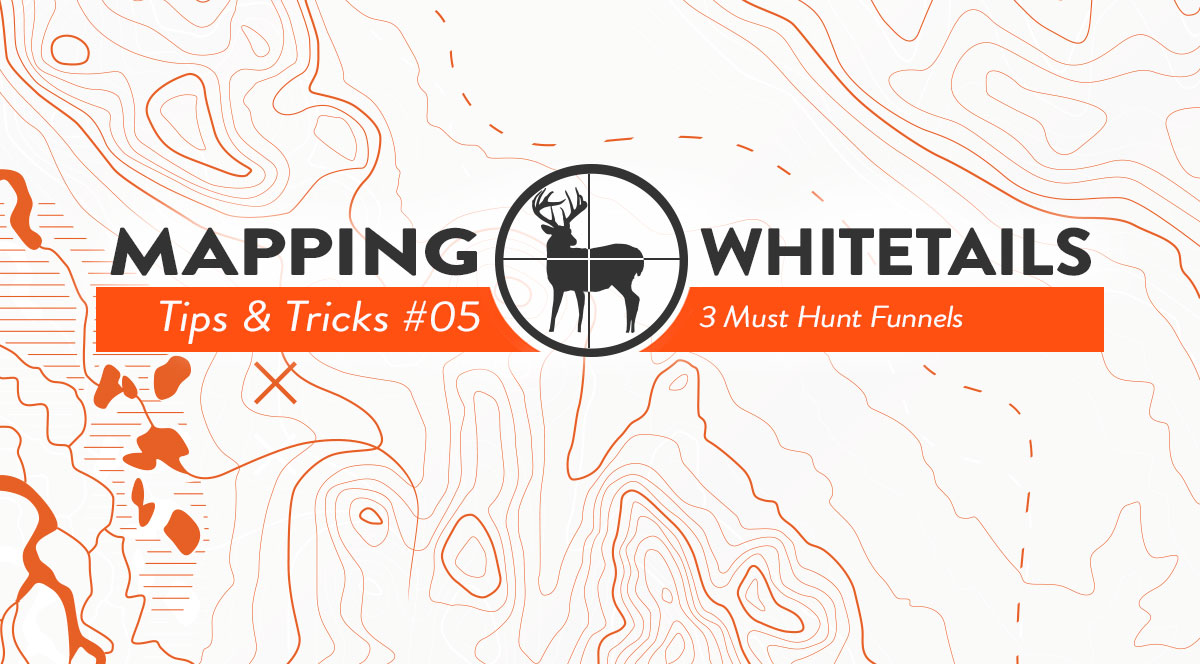The rut is near and soon enough many of us will be sitting our favorite stands, immersed in a frenzy of whitetail activity. It is truly a remarkable time in the woods…that is if you’re in the right spot of course. As with any Mapping Whitetails Blog, we are here to help put you right in the middle of the action.
Here are 3 dynamite locations to search for while you look for your next favorite rut stand. Once you find one, you’re likely in for years of success!
The Skinny Pinch
 This narrow band of cover connecting the two large blocks of cover is an ideal stand location for the rut.
This narrow band of cover connecting the two large blocks of cover is an ideal stand location for the rut.
Also commonly referred to by hunters as a bottleneck, funnel, or pinch point – it is exactly that, an area that funnels or condenses deer movement into a small channel. I’m sure you’ve heard them talked about a thousand times over, but do you know how to find them and hunt them with ease? Whether you do or you don’t, skinny pinches are fairly easy to find if they exist in your area.
They aren’t as common in big woods country, but they are quite prevalent anywhere ag or pasture land is scattered about the landscape. I prefer using an aerial map to find these pinch points as they are fairly obvious to identify. Keep in mind that not all pinches are created equally. Ideally, a short and narrow band of cover connecting two thick bedding areas is what you’re looking for. By narrow, I don’t necessarily mean tree line narrow, but rather something a deer can stay concealed in. Such corridors are usually around 10-60 yards wide. Other pinches can be created by terrain features such as steep bluffs, beaver ponds, or any other thing that may squeeze and direct deer to travel thru a narrow channel. If you find a good pinch, chances are it will produce year after year. I’d recommend hanging stands on both sides of the cover strip so you can hunt it on multiple wind directions.
The Open Gate
 Open gates may be tough to spot on an aerial map, but this one is pretty easy due to the mowed trail through the CRP field. I wish every hunter (myself included) had a spot to hunt like this.
Open gates may be tough to spot on an aerial map, but this one is pretty easy due to the mowed trail through the CRP field. I wish every hunter (myself included) had a spot to hunt like this.
An open gate can provide tremendous hunting if you can find one to set up over. They don’t typically stick out like a sore thumb on a map like the aforementioned skinny pinch, but can be just as powerful in terms of funneling deer past your stand. Decades of cattle fence are still left standing through much of the country. What was once grazing land for cattle has since been switched to cropland and overgrown brushy thickets. If you find a fence running through cover, follow it until you find an opening. This opening may be an open gate, broken fence section, or where a tree fell across. Is there a deer trail running through that opening? My guess will be yes, and it’s a likely a good spot to hunt during the rut.
Finding them may be difficult via Google Earth, but occasionally they stick out. Ones in the open tend to not be as hot as ones found within cover. You’ll likely need to put some boots on the ground to find the best fence gaps hidden in whitetail cover. One tip may be to follow manmade transition lines in the forest. These stick out on an aerial and give you a good place to start looking on the ground. When you notice an evident line within cover that is as straight as an arrow, you most likely found one. Check it out on the ground as there is a good chance a fence may be running along that line as well.
Fencerow Follower
 Though it doesn’t look like much, this long treeline likely sees many bucks running along it during the rut.
Though it doesn’t look like much, this long treeline likely sees many bucks running along it during the rut.
They can be boring, but effective. There’s A LOT of treelines spanning across the country and many times that is all we have to resort to as treestand hunters. Many times these stands are pretty boring as you’re stuck gazing over wide open country hoping a buck will appear out of thin air. However, all it takes is one hot doe to run along the fencerow and you’ll be sitting front row to a parade of revved up bucks. Land is constantly getting more and more fragmented which means these treelines and fencerows are the only band of cover connecting the larger blocks, making them ideal rut runways. There’s no real secret to finding them on the map as they stand out plain as day. The most productive ones are those that provide the lone cover strip between two large blocks of good cover or are along an attractive food source.
No funnels? No problem! Check out these 3 PRIME RUT STANDS.







